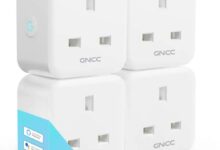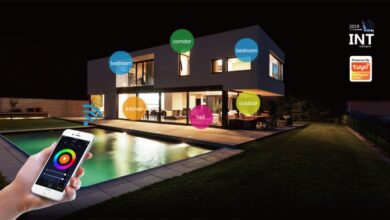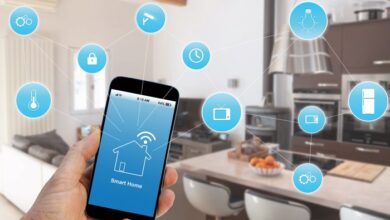Smart Thermostat Your Guide to Energy Savings
Smart Thermostat: Imagine a world where your home’s temperature perfectly anticipates your needs, adjusting automatically to save energy and money. This isn’t science fiction; it’s the reality offered by smart thermostats, devices that are revolutionizing home comfort and efficiency. From learning your preferences to integrating seamlessly with your other smart home gadgets, these innovative systems offer a level of control and convenience previously unimaginable.
Let’s dive into the world of smart thermostats and uncover their potential to transform your home and your energy bills.
This comprehensive guide explores the functionality, integration, energy efficiency, installation, market trends, security, and user experience aspects of smart thermostats. We’ll delve into the technical details, explore real-world applications, and address common concerns, providing you with the knowledge you need to make an informed decision about integrating this technology into your home. We’ll examine the various types available, comparing their features, benefits, and potential drawbacks, helping you choose the perfect smart thermostat for your specific needs and budget.
Smart Thermostat Functionality
Smart thermostats have revolutionized home energy management, offering a blend of convenience and cost savings. They go beyond basic temperature control, learning user habits and optimizing energy usage to significantly reduce energy bills. This level of intelligent control is achieved through a combination of sophisticated algorithms, connectivity options, and user-friendly interfaces.Smart thermostats perform several core functions. They allow for precise temperature control, scheduling, and remote access.
This means you can adjust the temperature from anywhere using a smartphone app, ensuring optimal comfort regardless of location. Beyond basic control, however, lies the real power of these devices.
Learning User Preferences
Smart thermostats employ machine learning algorithms to understand and adapt to user preferences. By tracking temperature adjustments, occupancy patterns, and even external weather conditions, the thermostat learns the ideal temperature settings for different times of day and circumstances. For example, if the thermostat consistently observes a lower temperature setting during sleep hours, it will automatically adjust to that preference, minimizing energy waste during unoccupied periods.
This learning process refines over time, leading to increasingly efficient and personalized temperature control. The more data the thermostat collects, the better it becomes at predicting and fulfilling user needs.
Smart Thermostat Connectivity
Several connectivity options are available for smart thermostats, each offering unique advantages. Wi-Fi is the most common, providing broad range and reliable connectivity to home networks. This allows for seamless remote control via smartphone apps. Bluetooth offers a shorter-range alternative, often used for local control and initial setup. Z-Wave is a mesh networking protocol, allowing thermostats to communicate with other smart home devices and potentially enhance home automation capabilities.
The choice of connectivity depends on individual needs and existing home infrastructure. A home with robust Wi-Fi would benefit from a Wi-Fi enabled thermostat, while a home using a Z-Wave ecosystem might benefit from a Z-Wave thermostat for better integration.
Energy-Saving Features Comparison
Different smart thermostat models offer varying energy-saving features. Some models incorporate “geo-fencing,” automatically adjusting temperatures based on the location of household members, ensuring energy isn’t wasted when the home is unoccupied. Others offer advanced algorithms that optimize heating and cooling cycles based on weather forecasts, preemptively adjusting temperatures to maintain comfort while minimizing energy consumption. Features like “away” modes automatically lower temperatures when no one is home, while “vacation” modes offer extended periods of energy savings.
Nest Learning Thermostat, for instance, is known for its sophisticated learning algorithms, while ecobee smart thermostats often highlight their ability to integrate with multiple sensors for more precise temperature control across the home. The best choice depends on the specific energy-saving features prioritized by the user. For instance, a user with a large, poorly insulated home might prioritize a thermostat with advanced predictive capabilities, while a user in a well-insulated home might prioritize a simpler model with strong geo-fencing.
Smart Thermostat App User Interface Design
A user-friendly app is crucial for the effective use of a smart thermostat. The interface should prioritize intuitive navigation and clear visual representation of data. A clean, uncluttered layout, with easily accessible controls for temperature adjustment, scheduling, and mode selection is essential. A large, clear display showing the current temperature and scheduled temperature changes should be prominent. A simple color-coded system could indicate heating or cooling cycles, while clear visual representations of energy usage could motivate users to conserve energy.
The app should also offer easy access to settings, historical data, and troubleshooting options. For example, a user should be able to easily view their energy usage over time and compare it to previous periods, providing a clear visual representation of the impact of their thermostat adjustments. Furthermore, the app should provide clear and concise explanations of the various features and settings, ensuring a seamless and informative user experience.
Smart Thermostat Integration with Other Smart Home Devices
The true power of a smart thermostat isn’t just in its ability to optimize your energy consumption; it lies in its potential for seamless integration within a broader smart home ecosystem. Connecting your thermostat to other smart devices unlocks a world of automated convenience and enhanced energy efficiency, transforming your home into a truly connected and responsive environment. This integration allows for sophisticated automation scenarios, boosting comfort and potentially saving you money on your energy bills.
However, it’s crucial to understand the security implications and potential compatibility challenges involved.Smart thermostats, when integrated with other smart home devices, offer a significant boost in convenience and efficiency. This integration creates opportunities for automated actions triggered by various conditions, optimizing energy use and personal comfort based on real-time data and user preferences. For example, imagine a system that automatically lowers the temperature when you leave for work and raises it again just before your arrival, based on your phone’s location.
This level of automation goes beyond simple scheduling and adapts dynamically to your lifestyle.
Automation Scenarios
Integrating a smart thermostat opens doors to various automation possibilities. Imagine a scenario where your smart speaker detects your voice command to “set the living room to 72 degrees,” instantly adjusting the thermostat. Alternatively, your smart lighting system could be programmed to dim the lights as the thermostat lowers the temperature for sleep, creating a relaxing ambiance. Another example: your smart security system could detect an intrusion and automatically raise the temperature to make the house less appealing to intruders while simultaneously notifying you.
These scenarios highlight the potential for coordinated actions that enhance both comfort and security.
Security Implications
The integration of smart thermostats into a smart home ecosystem introduces new security considerations. A compromised thermostat could provide a point of entry for malicious actors to access other devices on your network. Therefore, strong passwords, regular software updates, and robust network security measures are crucial. Choosing reputable brands with established security protocols is also essential. Consider the implications of data collection: some thermostats collect extensive data about your energy usage and home temperature patterns.
Understand what data is collected, how it is used, and what security measures are in place to protect your privacy. The potential for unauthorized access or data breaches necessitates a proactive approach to security.
Compatibility Issues
Integrating smart home devices from different manufacturers can lead to compatibility problems. Not all smart thermostats and smart home hubs communicate seamlessly. Different protocols (such as Zigbee, Z-Wave, Wi-Fi) may create interoperability challenges. Before purchasing a smart thermostat, it’s essential to check its compatibility with your existing smart home devices and hub. Incompatibility can lead to frustration and limited functionality.
Thorough research and careful selection are key to avoiding compatibility issues and ensuring a smooth integration.
Smart Thermostat and Smart Home Hub Communication
The following illustrates the communication flow between a smart thermostat and a smart home hub:
A typical interaction begins with the smart thermostat sensing a change in temperature or receiving a command from the user interface (app or voice command). This information is then transmitted to the smart home hub via a chosen communication protocol (e.g., Wi-Fi, Zigbee). The smart home hub processes the information, potentially integrating it with data from other devices, and then sends instructions back to the thermostat to adjust the temperature or perform other actions. This two-way communication ensures a dynamic and responsive smart home environment.
Smart Thermostat Energy Efficiency and Cost Savings

Smart thermostats are revolutionizing home energy management, offering significant potential for both environmental responsibility and financial gain. By intelligently adapting to your lifestyle and external factors, these devices can dramatically reduce energy consumption and lower your monthly bills. Let’s delve into the specifics of how these savings are achieved and the factors that influence their magnitude.
Smart thermostats achieve energy efficiency primarily through two key mechanisms: occupancy detection and weather compensation. Occupancy sensing allows the thermostat to automatically adjust temperatures based on whether someone is home. When the house is empty, the thermostat can lower the heating or cooling, saving significant energy. Weather compensation, on the other hand, anticipates temperature fluctuations based on external weather data and adjusts the heating or cooling proactively, preventing unnecessary energy expenditure.
This intelligent approach leads to substantial energy savings compared to traditional thermostats.
Potential Energy Savings with Smart Thermostats
Studies consistently demonstrate that smart thermostats can lead to substantial energy savings. For example, a study by the Department of Energy found that homes using smart thermostats reduced their energy consumption by an average of 10-12%. This translates to significant cost savings, especially in regions with high energy prices. Consider a household with an average annual energy bill of $1500; a 10% reduction would result in savings of $150 annually.
This illustrates the substantial financial benefits of investing in a smart thermostat. Moreover, some utilities offer rebates for installing smart thermostats, further reducing the upfront cost.
Optimization of Energy Consumption
Smart thermostats optimize energy consumption through a combination of algorithms and user-defined preferences. They learn your heating and cooling habits over time, creating a personalized schedule that aligns with your lifestyle. This learned behavior allows the system to anticipate your needs and preemptively adjust the temperature, maximizing energy efficiency. Furthermore, geofencing capabilities allow the thermostat to automatically adjust the temperature based on your location, ensuring energy is not wasted when you are away from home.
This intelligent adaptation is a significant departure from traditional programmable thermostats which often require manual adjustments and fail to account for unforeseen changes in occupancy or weather.
Factors Influencing Cost Savings
Several factors influence the extent of cost savings realized with a smart thermostat. The size and insulation of your home play a crucial role; better-insulated homes will see greater savings. Your climate also significantly impacts energy consumption; homes in extreme climates will benefit more from smart thermostats’ capabilities. Finally, your personal energy usage habits and the specific features of the smart thermostat chosen will influence the overall cost savings.
For example, thermostats with advanced features like geofencing and learning algorithms typically offer greater energy efficiency than simpler models.
Smart Thermostat vs. Programmable Thermostat: Long-Term Cost Savings
While programmable thermostats offer some level of energy efficiency, smart thermostats surpass them significantly in long-term cost savings. Programmable thermostats require manual scheduling and often fail to adapt to changes in occupancy or weather. Smart thermostats, however, automatically adjust to these variables, resulting in consistently higher energy savings. The initial investment in a smart thermostat is usually higher, but the cumulative energy savings over several years significantly outweigh the upfront cost.
A conservative estimate suggests that the energy savings from a smart thermostat can recoup the initial investment within 1-3 years, depending on usage and energy prices.
Energy Efficiency Ratings of Smart Thermostat Models
| Model | Energy Star Rating | Estimated Annual Energy Savings (%) | Key Features |
|---|---|---|---|
| Nest Learning Thermostat | 5 stars | 10-15% | Learning algorithms, geofencing, energy reports |
| Ecobee SmartThermostat | 5 stars | 10-12% | Remote sensor integration, Alexa compatibility, smart home integration |
| Honeywell Home T9 Smart Thermostat | 4 stars | 8-10% | Room sensors, smart home compatibility, voice control |
| Emerson Sensi Smart Thermostat | 4 stars | 8-12% | Easy installation, smartphone app control, remote access |
Smart Thermostat Installation and User Experience
Upgrading your home’s thermostat to a smart model offers significant advantages, from enhanced energy efficiency to convenient remote control. However, the journey from purchase to seamless integration isn’t always straightforward. A smooth installation process and an intuitive user experience are critical for maximizing the benefits of your investment. This section delves into the practical aspects of installation, potential challenges, and the user interface nuances that define the overall smart thermostat experience.
Smart Thermostat Installation Steps
A successful smart thermostat installation hinges on careful planning and execution. While specific steps may vary slightly depending on the model, the general process remains consistent. Proper preparation significantly reduces the likelihood of encountering problems. Following these instructions meticulously ensures a trouble-free installation.
- Turn off the power: Before commencing any work, switch off the power supply to your existing thermostat at the breaker box. This crucial safety precaution prevents electrical shocks and potential damage to the device.
- Remove the old thermostat: Gently detach the old thermostat from the wall plate, taking note of its wiring configuration. Photographing the wiring before disconnecting can be incredibly helpful. Carefully label each wire for easy reconnection later.
- Prepare the wall plate: Clean the wall plate thoroughly to ensure a secure fit for the new thermostat. Remove any dust or debris that could interfere with proper adhesion.
- Connect the wires: Carefully connect the wires from your new smart thermostat to the corresponding terminals, matching the color codes and labels from your previous thermostat. Refer to your smart thermostat’s installation manual for specific instructions and diagrams.
- Mount the thermostat: Securely attach the smart thermostat to the wall plate. Ensure it’s level and firmly mounted to prevent future detachment.
- Restore power: Turn the power back on at the breaker box. The smart thermostat should now power up and begin its initial setup process.
- Complete the app setup: Download the manufacturer’s app and follow the on-screen instructions to connect the thermostat to your home Wi-Fi network and complete the initial configuration.
Common Smart Thermostat Installation Challenges and Solutions
While the installation process is generally straightforward, several common challenges can arise. Addressing these proactively ensures a smooth and successful installation. Proactive problem-solving saves time and frustration.
| Challenge | Solution |
|---|---|
| Incorrect wiring | Carefully double-check the wiring diagram provided in your thermostat’s manual. Consult a qualified electrician if you are unsure. |
| Compatibility issues | Ensure your smart thermostat is compatible with your existing HVAC system. Check the manufacturer’s specifications for compatibility details. |
| Wi-Fi connectivity problems | Ensure your Wi-Fi signal is strong enough to reach the thermostat’s location. Consider using a Wi-Fi extender if necessary. |
| Calibration issues | Follow the manufacturer’s instructions for calibrating the thermostat to ensure accurate temperature readings. |
Smart Thermostat App User Experience
The user experience of a smart thermostat app significantly impacts user satisfaction and adoption. A well-designed app simplifies control, enhances functionality, and provides valuable insights into energy consumption. Understanding app features and navigation is key.The user interface should be intuitive and visually appealing. Features like scheduling, geofencing, and energy reporting should be easily accessible. For example, the Nest app is renowned for its clean design and ease of use, while other apps may prioritize different features, leading to varying levels of user-friendliness.
App reviews often highlight usability concerns, offering valuable insights into the strengths and weaknesses of various platforms. Comparing multiple apps before purchasing a thermostat is advisable.
Troubleshooting Common Smart Thermostat Problems
Smart thermostats, while technologically advanced, are not immune to occasional malfunctions. Having a basic troubleshooting guide at hand is beneficial for addressing minor issues independently. A quick fix can prevent unnecessary service calls.
“Prevention is better than cure. Regularly checking your thermostat’s connections and software updates can prevent many issues.”
A common problem is the thermostat failing to connect to Wi-Fi. This is often resolved by checking the router’s settings, restarting the thermostat, or ensuring the thermostat is within range of the Wi-Fi signal. Another common issue is inaccurate temperature readings, which might require recalibration or checking the thermostat’s sensor. For more complex issues, consulting the manufacturer’s support documentation or contacting customer support is recommended.
Smart Thermostat Market Trends and Future Innovations
The smart thermostat market is experiencing rapid evolution, driven by advancements in technology, increasing consumer awareness of energy efficiency, and the growing adoption of smart home ecosystems. This dynamic landscape presents both opportunities and challenges for manufacturers and consumers alike, shaping the future of home climate control. Understanding current trends and anticipating future innovations is crucial for navigating this exciting space.
Current Trends in the Smart Thermostat Market
Several key trends are currently shaping the smart thermostat market. These trends are not isolated events but rather interconnected forces driving innovation and adoption. The convergence of improved user interfaces, advanced connectivity, and sophisticated algorithms is leading to a more personalized and responsive home climate experience.
The Impact of Artificial Intelligence on Smart Thermostat Technology
Artificial intelligence (AI) is poised to revolutionize smart thermostat technology. AI-powered systems can learn individual preferences and optimize energy usage based on occupancy patterns, weather forecasts, and even energy prices. For example, Nest Learning Thermostat uses AI to learn your heating and cooling preferences, gradually adapting its schedule to your routine. This level of personalization leads to significant energy savings and enhanced comfort.
Beyond simple learning, AI algorithms can predict future energy needs, proactively adjusting the thermostat to maintain optimal temperatures and prevent energy waste. This predictive capability represents a significant step forward in energy management.
Future Innovations in the Smart Thermostat Industry
Looking ahead, several innovations are likely to shape the future of smart thermostats. Increased integration with other smart home devices, improved energy efficiency through advanced algorithms, and more intuitive user interfaces are just a few examples. The development of more sophisticated predictive models, capable of anticipating user needs and optimizing energy consumption with greater precision, is another key area of innovation.
Imagine a thermostat that anticipates your return home from work and pre-heats or pre-cools your house accordingly, all while optimizing energy usage based on real-time energy pricing. This level of proactive energy management is a realistic possibility in the near future.
Comparison of Smart Thermostat Brands Based on Innovation
Several leading brands are at the forefront of smart thermostat innovation. Nest, for example, has established itself as a market leader through its user-friendly interface and advanced learning capabilities. Ecobee, on the other hand, stands out with its room sensors and advanced smart home integration. Honeywell offers a range of thermostats, catering to various needs and budgets, while focusing on reliability and ease of installation.
Each brand offers unique features and technological advancements, catering to different consumer preferences and priorities. A detailed comparison would highlight the strengths and weaknesses of each brand across various criteria, including AI capabilities, energy efficiency features, and smart home integration options.
Timeline of Smart Thermostat Technology Evolution
The evolution of smart thermostat technology can be traced back several decades. Early programmable thermostats provided basic scheduling capabilities. The introduction of Wi-Fi connectivity marked a significant leap, enabling remote control and monitoring. The advent of AI-powered learning algorithms represents the most recent and perhaps most significant advancement, enabling personalized comfort and enhanced energy efficiency. Future developments will likely focus on even more sophisticated AI, advanced energy management capabilities, and seamless integration within broader smart home ecosystems.
A visual timeline, charting key milestones in smart thermostat technology, would clearly illustrate this progression.
Smart Thermostat Security and Privacy Concerns
The increasing popularity of smart thermostats brings convenience and energy savings, but also raises legitimate concerns about security and privacy. These devices, constantly connected to the internet and collecting data about your home’s temperature and your usage patterns, represent a potential vulnerability if not properly secured. Understanding these risks and implementing appropriate safeguards is crucial for protecting your personal information and maintaining the integrity of your smart home ecosystem.Smart thermostat manufacturers acknowledge these concerns and are actively implementing measures to enhance security.
However, the responsibility for maintaining a secure smart home environment ultimately rests with the user. This section will explore the security risks, manufacturer responses, user actions, and best practices for ensuring your smart thermostat remains a valuable asset, not a liability.
Security Risks Associated with Smart Thermostats
Smart thermostats, by their very nature, are connected devices. This connectivity, while offering remote control and automation, creates potential entry points for malicious actors. These risks include unauthorized access to the device, allowing a hacker to remotely control your heating and cooling system, potentially leading to discomfort or even property damage. More critically, a compromised thermostat could serve as a gateway to other devices on your home network, exposing sensitive data stored on other smart home devices or your home computer.
Data breaches could expose personal information, including your daily routines and energy consumption habits, which can be used for targeted advertising or even identity theft. For example, a hacker could glean information about when you are home or away based on temperature changes, enabling them to plan burglaries. The risk is further amplified by vulnerabilities in the device’s firmware or the associated mobile application.
Manufacturer Responses to Security and Privacy Concerns
Many smart thermostat manufacturers employ various security measures to mitigate these risks. These include robust encryption protocols to protect data transmitted between the thermostat and the cloud, secure authentication mechanisms to verify user identity, and regular software updates to patch vulnerabilities. Many manufacturers also offer two-factor authentication, requiring a secondary verification step beyond a password, for increased security.
Furthermore, they implement data anonymization techniques, reducing the identifiability of collected data to protect user privacy. For example, Nest, a prominent smart thermostat manufacturer, uses end-to-end encryption and regularly releases security updates to address potential vulnerabilities. However, the effectiveness of these measures varies between manufacturers and models.
User Actions to Enhance Smart Thermostat Security
Users can significantly improve the security of their smart thermostats by taking proactive steps. This includes regularly updating the thermostat’s firmware and the associated mobile application to benefit from the latest security patches. Choosing a strong, unique password, distinct from other online accounts, is paramount. Enabling two-factor authentication adds an extra layer of protection, making unauthorized access significantly more difficult.
Users should also be wary of phishing attempts and avoid clicking on suspicious links or downloading untrusted applications. Regularly reviewing the thermostat’s network settings and ensuring that only trusted devices are connected to your home network is another crucial step. Furthermore, understanding the data collected by the thermostat and the manufacturer’s privacy policy is essential for informed consent and responsible usage.
Comparison of Security Features Across Smart Thermostat Models
The security features of smart thermostats vary considerably depending on the manufacturer and the specific model. Some models offer more advanced features such as end-to-end encryption and two-factor authentication, while others rely on less robust security measures. A detailed comparison across different models requires in-depth technical analysis, but consumers should research security features before purchasing a smart thermostat.
Consider reading independent reviews and security audits to gain a better understanding of the security strengths and weaknesses of various models. Look for thermostats with a strong reputation for security updates and a transparent privacy policy.
Best Practices for Securing a Smart Thermostat
To summarize, securing your smart thermostat involves a multi-pronged approach. It’s crucial to choose a reputable manufacturer with a proven track record of security updates and transparent privacy policies. Always use a strong, unique password and enable two-factor authentication if available. Regularly update the thermostat’s firmware and the associated mobile application. Be vigilant against phishing attempts and avoid clicking on suspicious links.
Review your network settings regularly to ensure only trusted devices are connected. Understand the data collected by the thermostat and the manufacturer’s privacy policy. By implementing these best practices, you can significantly reduce the risk of security breaches and protect your privacy.
Smart Thermostat Visual Representation
The visual design of a smart thermostat significantly impacts user experience and overall adoption. A well-designed interface facilitates intuitive control and monitoring, while a poorly designed one can lead to confusion and frustration. This section explores the visual elements of smart thermostats, their accompanying apps, and how data is presented to users.Smart thermostats boast a variety of visual styles, catering to different aesthetic preferences and home décor.
The physical device itself typically features a display screen, ranging from simple monochrome LCDs to vibrant color touchscreens. Button designs vary; some employ traditional physical buttons, while others opt for touch-sensitive controls integrated seamlessly into the display. Many prioritize minimalist designs with clean lines and a focus on readability, while others integrate more intricate visual elements like textured surfaces or decorative bezels.
For instance, a high-end model might feature a sleek glass touchscreen with subtle backlighting, whereas a budget-friendly option may use a simpler plastic casing with easily visible buttons and a less sophisticated display.
Smart Thermostat Display Design
The display screen is the primary visual interface of a smart thermostat. High-resolution color screens offer a rich visual experience, allowing for detailed graphical representations of data and customizable backgrounds. Lower-resolution monochrome displays, while less visually appealing, are often more energy-efficient and easier to read in direct sunlight. The size of the display also impacts usability; larger screens allow for more information to be displayed simultaneously, while smaller screens prioritize compactness.
Font sizes and styles are crucial for readability; clear, easily legible fonts are essential for users of all ages and visual acuity levels. The use of icons and symbols can enhance user understanding, but overuse can lead to visual clutter. A successful design balances visual appeal with functional clarity. Consider Nest’s thermostats; their circular displays and minimalist aesthetic prioritize a clean, uncluttered look, while Ecobee’s models often include more detailed information on the screen.
Smart Thermostat App User Interface
The accompanying smartphone app provides an extended interface for controlling and monitoring the smart thermostat remotely. Effective visual hierarchy is crucial for app usability. Typically, the app’s home screen prominently displays the current temperature, target temperature, and a visual representation of the thermostat’s mode (heating, cooling, or off). Larger fonts and clear icons are used for key functions, while less critical information is presented in a smaller, less prominent font size.
Color coding is often used to highlight important data points, such as high energy consumption periods or unusual temperature fluctuations. The information architecture should be intuitive and logically organized. For example, energy consumption data might be presented in a dedicated section, accessible through a clear navigation menu. The app might employ a card-based layout, presenting different data points and control options in separate, easily digestible blocks of information.
Many apps use charts and graphs to visualize energy consumption trends over time, providing a visual representation of how energy usage patterns change.
Data Visualization in Smart Thermostat Apps
Smart thermostat apps effectively visualize energy consumption and temperature settings using various graphical representations. Line graphs are commonly used to display temperature fluctuations over time, showing the relationship between set temperature and actual room temperature. Bar charts or pie charts might be used to illustrate energy consumption across different time periods (daily, weekly, monthly), providing users with a clear picture of their energy usage patterns.
Color coding is used to highlight periods of high energy consumption or significant temperature variations. For instance, a darker shade of blue might represent higher energy usage, while a lighter shade represents lower usage. Interactive elements, such as zoom and pan functionalities, allow users to explore data in more detail. Many apps also provide clear summaries of energy usage and cost savings, often using both numerical and graphical representations.
For example, an app might display a summary stating “You saved $50 this month compared to last month,” accompanied by a bar chart visually representing the savings. The goal is to present complex data in a clear, understandable, and engaging manner.
Concluding Remarks
Ultimately, the smart thermostat represents a significant leap forward in home automation and energy management. By leveraging intelligent technology and seamless integration with other smart home devices, these systems offer unparalleled convenience, substantial cost savings, and a reduced environmental footprint. While security and privacy considerations are important factors to weigh, the benefits of a smart thermostat – from optimized comfort to significant long-term cost reductions – make it a compelling investment for the modern homeowner.
Take control of your home’s climate and your energy consumption; embrace the future of home comfort with a smart thermostat.








